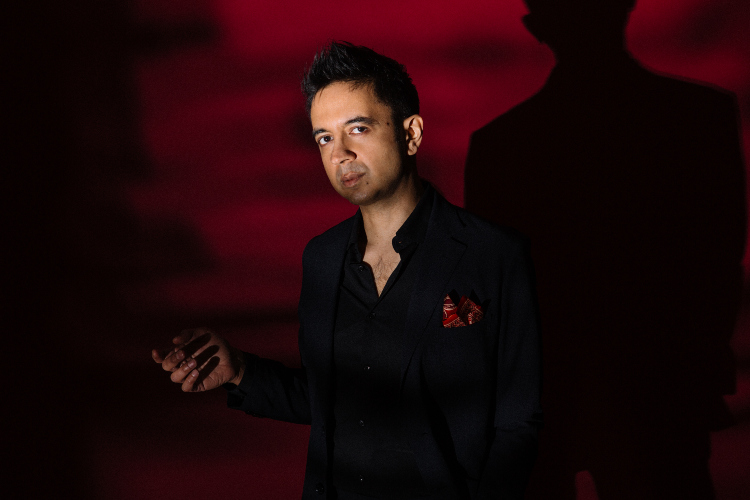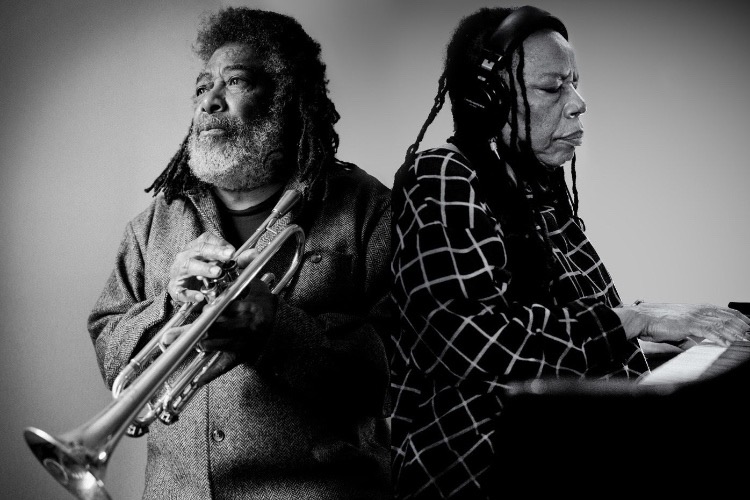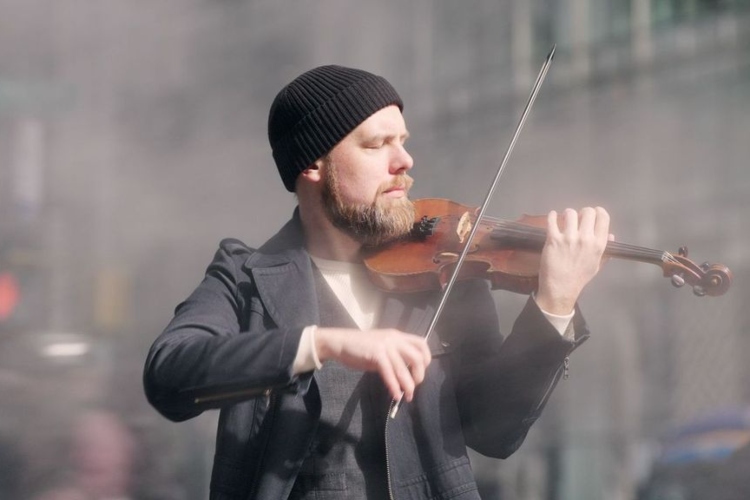Magic is Real: Vijay Iyer Previews the ‘Love in Exile’ Trio’s 2023 Newport Jazz Festival Performance
|
Getting your Trinity Audio player ready...
|
Often the best music seemingly transports the listener – by the artist’s direction – to another time and place. The music envelopes the audience, disorienting them temporarily but ultimately giving them a path to follow. While recordings can capture this mystifying experience, it is truly the live performance in which this intangible aspect is at its most tangible. This difference between live performance and recording is particularly pronounced when the artists create in the moment, as an in-person experience directly pulls the listener in. A case study of these concepts is the trio of vocalist Arooj Aftab, pianist Vijay Iyer, and bassist/synthesist Shahzad Ismaily and their upcoming performance at the Newport Jazz Festival .
For reasons we will discuss in a future posting, the trio’s album, Love in Exile (Verve, 2023), is an intoxicating genreless exposition on the power of communication without preconceptions, or pre-written ideas. The three artists compose fully in the moment and see where the music itself leads them. The project fully depends on the artists and their strengths and openness to becoming fully engulfed by the music and their ability to bring audiences with them on their journey. As great as their recording is, the group’s approach is practically born for live performance, where they can most directly pull other listeners into their atmosphere.
To readers of this site, Iyer likely needs little introduction. He is a master of providing form to the seemingly nebulous. The pianist’s background in physics taught him the building blocks of the universe and how matter – and sonic elements – pass through time and space. His doctoral studies in music cognition emphasized the use of macrostructures of sound. And in the years since, Iyer’s built a career out of styling components of sound into mesmerizing configurations. Along the way, it’s found him collaborating with living legends of the music, including Wadada Leo Smith, Butch Morris, Henry Threadgill, Roscoe Mitchell, and George Lewis. It has also earned him the designations of Harvard professor, four-time Downbeat Jazz Artist of the Year, Grammy nominee, and MacArthur Genius.
We sat down with Iyer to discuss the Love in Exile trio’s forthcoming Newport Jazz Festival performance and the role of the audience in the group’s music-making.
PostGenre: You first performed at the Newport Jazz Festival in 2003.
Vijay Iyer: That could be true. Yeah, I think it was with a quartet with Tyshawn [Sorey], Rudresh [Mahanthappa], and Stephan Crump.
PG: As an artist who has performed there several times over the last twenty years, how do you feel the Festival has changed during that period?
VI: That’s a good question.
I think after George [Wein] passed the helm onto Christian [McBride], much of the Festival still felt similar in terms of curatorial emphasis. But I would say that there has been a slight shift. Something happens when you have a musician as central as McBride at the helm. He’s not second-guessing audiences. George had to fight to get a place on the world stage for this music. He did that by highlighting certain aspects of [the music]; a kind of exuberance and intensity of the music. Many of the classic Newport live recordings people remember have a blazing intensity.
PG: Like on Ellington at Newport (1956, Columbia).
VI: Right, like Paul Gonsalves’ solo on “Diminuendo and Crescendo in Blue.” Or even the new release by Nina Simone [You’ve Got to Learn (Verve, 2023)] that came out just the other day. Or, the recordings by Coltrane or Miles. The increased intensity is partly because the Festival is outdoors, and artists are kind of using their outside voices when playing. But there’s also an iconic swagger and a certain kind of command that is very extroverted. I would say that in the last several years, that has changed a little.
PG: What makes you think the Festival is now more accepting of quieter or more introverted groups?
VI: In 2017, I did three things at Newport. I did a duo with Wadada [Leo Smith], I played with my sextet, and I was part of a tribute to Geri Allen. The tribute was supposed to have been her gig with Esperanza [Spalding] and Terri Lyne [Carrington], but then Geri passed. I remember wondering at the time whether Wadada would have ever played Newport before McBride took over. I’m not sure that it would have happened. But now it feels like you don’t have to prove to anyone that you belong there based on how you sound, only the quality of your work.
PG: Do you think part of the programming shift you describe may come from a generational shift between Wein and McBride?
VI: I don’t know. I mean, Wadada is now eighty-one years old.
I think the difference is just that McBride is part of more stuff. He’s aware of a lot more music just by having been in it the way that he has. That’s no shade to George Wein, but George was who he was. He was an impassioned promoter first, with his own likes and dislikes. I think, particularly because he’s a bass player, McBride has been at the heart of a lot of very different music. He’s worked with people like Laurie Anderson…
PG: James Brown
VI: and David Sanborn. Even just now, he posted a picture of himself with Renée Fleming. McBride is certainly an iconic jazz bassist. But he’s also somebody who knows and sees the entire musical landscape from within. I think that perspective is reflected little by little in how things manifest at the Festival.
I will also say though, that over the last few years, with the pandemic shutting places down, a lot of people went online to find music. From that, we’ve now ended up with what I, unfortunately, dubbed “viral jazz.” The idea is that now there is a phenomenon of music that seems to be the kind that gets attention online and provides a concentrated dose of a certain aesthetic. This kind of music has been a new, but very major, presence at all the international festivals. That wasn’t true before last summer.
“Viral jazz” draws many young people, but I find that it is also a little ahistorical. Those artists provide a concentrated dose of virtuosity that is a little more removed from this history of the music. I don’t mean to disparage those artists. They are just different from what came before.
PG: Do you ever feel pressure to do anything differently to respond to the music of these viral musicians you mention?
VI: My instinct is not to change in response. I remember an older way that I learned from the elders who mentored me. I feel that I need to represent that.
PG: Of course, coming out of the tradition does not mean not finding new sounds or ideas to explore. Last summer, you were at Newport with your trio with Tyshawn Sorey and Linda May Han Oh. This summer, you will be there with the Love in Exile trio with Arooj and Shahzad. Both are structured as trios but sound distinctly different from one another.
VI: Well, last summer Tyshawn ended up getting COVID that weekend. Jeremy Dutton ended up playing with us as he has many, many times. We were still able to be there and deliver something, but it was a bummer Tyshawn wasn’t there. Tyshawn was bummed most of all. He was so excited to bring his drums and make a weekend of it.
PG: Ah, that’s right. But in a more general sense, do you feel there is anything from the trio with Tyshawn and Linda that has carried over to your work with Arooj and Shahzad, or vice-versa?
VI: Interesting.
The trio with Linda and Tyshawn recorded Uneasy (ECM, 2021) towards the end of 2019. After recording the album, we didn’t do much for a while. Then in the Fall of 2021, we started doing a lot of playing out in the world and touring. We started evolving quite a bit as a band to the point where the trio is a different animal than it was originally. It is a much richer experience now than it was when we recorded Uneasy. I have a long history with Tyshawn; about twenty-two years and counting. And a fairly long one with Linda as well; about a decade. Because of those long relationships, it’s not like we didn’t know how to play together. But every time out, we explore how we can further push ourselves and how we can further push the format to see what’s possible in terms of ensemble synchrony and the flow of an entire concert.
I have been doing this before, but with that trio, I tend to play a continuous set with segues between pieces. We create these segues, and then I find an escape hatch into another piece. A lot of that is also very real-time. We don’t have a planned set list or anything like that. The whole thing kind of flows. I am still steering the trio in the sense that I’m making those transitional choices, but the music all flows as if one large-scale experience rather than a bunch of tunes.
I’d say that flow of music is certainly something the trio with Tyshawn and Linda has in common with the trio with Arooj and Shahzad. Arooj, Shahzad, and I have been using the term “live composing” to describe the music we make, which just means that the music is being created and discovered as it’s being heard. There’s no repertoire or premade song list. Instead, we take an idea, build with that idea, and create the entire set that way. It tends to be a very patient and vulnerable process that is very tender. We take our time because you can’t really rush that. We don’t cut to the chase or something. The music has a continuous flow quality that is maybe similar to the other trio.
I think another thing that the two trios have in common is simply a consequence of their size. You can cover a lot of ground with three people doing three different things. And then when things merge – when those different elements merge, synchronize, or line up – it feels like a miracle, particularly for an observer. Sometimes, when I see footage of either group, it feels like everything’s coming out of nowhere.
PG: There certainly seems to be a magical energy that comes out in the musical communication between you, Arooj, and Shahzad. Given your doctoral studies focused on musical cognition, do you feel there is a cognitive explanation for the special connection the three of you seem to share?
VI: Are you asking if magic is real? [laughing]. Yes, magic is real.
But, no, I think many of those witnessing us making music have some sense that music is just boiled down to some essential set of elements. But the real reason it is possible to make such music isn’t a list of elements. It is because of listening. When you watch people listen, they don’t seem to be doing anything in particular. That’s why musical communication seems to come out of nowhere. It comes from that part of us that listens. There’s nothing to see really.
PG: Though the audience may pick up on cues or ideas as they are developed.
VI: I think if you watch that Tiny Desk Concert the trio did, you do see something like music forming from its component parts. Some very tactile gestures that sustain. Things that sound like they are happening in quasi-unison. Forms emerging and receding. The pulse emerging and receding. Those sorts of things give a sense of how much of what we make fits the description of music if you dismantle it using a modern framework where music has clear beginnings and endings and limits to its form based on some category. We seem to dwell just right on the edge of category. Our music seems to come from almost nothing and then recedes to almost nothing. And, in the midst of it, there is a feeling, a lot of intention, and a lot of unity in it that seems to come from disparate components.
Part of what’s happening is that, as a listener, you are being reminded that music is not a thing. It’s an act. It’s a collective act. There is a conceptual shift that happens when you’re brought into awareness of music not as an object, but as an action, as a process. And the audience members are implicated in that process as observers because it is unfolding in a way that puts them in it with us.
I don’t know if that’s a cognitive explanation so much as a philosophical one. There is a philosopher who gets associated with cognitive sciences named Alva Noë. He has written about experiential forms, like a form as an experiencer. About twenty years ago, he wrote about types of visual art, focusing on sculptures and public large-scale works that are experiential rather than something as an object that you apprehend all at once. As one example, you could consider the work of Richard Serra, the sculptor who makes these large-scale slabs of steel that have a weird curvature to them. The works are all about how you encounter them with your body, the temporality of that process, and the weird thing it does to distort your perspective and field of vision. You don’t just look at the works and say “Oh, I see it now.” You actually move through the work. It is the temporality of that movement that matters. I think there’s something about this music that’s kind of like that; that feels like you have to live through it with us. Listening to it is like living in it with us.
PG: Which seemingly emphasizes the importance of spontaneity and the moment in which the music is created. The trio performed together only a few times before recording Love in Exile, but the three of you have performed together several times since. Do you feel it is more difficult to approach this music with an open mind of creating in the moment when you probably now have a better idea of what the other two members of the trio, Arooj and Shahzad, will do in response to a particular thing compared to when the group was new?
VI: You know, I was worried about that. I think we all were a little bit. We were worried that magic would wash away after too many shows. We had done half a dozen performances before we recorded Love in Exile. Those shows were all in 2018 or 2019. Then we made the record. We sat on it a few years before putting it out, but have been touring a lot in the last several months with much more to come. We have another seventeen or eighteen shows scheduled between now and October.
We have noticed certain things about the process of making this music. At each performance, It seems that each form we create lasts somewhere between 15 and 20 minutes long. Sometimes they are shorter, maybe even as short as 12 minutes. But, on average, around 15 minutes per form. That seems to be the timescale of whatever we are working with. And then if we stop there, before we start again, we all get to take a breath together. Not just us, but the audience too. The audience also gets to take a breath with us and then start again.
But with 15 minutes a form, how many forms are enough for a concert? Is it 3? 4? 5? With each, we are trying to move away from what we just did. But it is also hard to remember what we just did because the music often passes through us. We’re not really retaining a lot of it. We do notice certain basic patterns, but a lot of it depends on the space we’re in and the audience that’s with us.
I think Newport is going to be an interesting test for us. Despite what I said earlier, to some extent, Newport is still a kind of space where you use your outside voice. People are milling around, and you can hear the other stages while playing. There can be a lot of distractions, and this trio’s music doesn’t tolerate distractions. It will be an interesting challenge for us.
Catch Vijay Iyer with Arooj Aftab and Shahzad Ismaily at the Newport Jazz Festival on Saturday, August 5, 2023. The trio will perform at 4:05 PM on the Quad Stage. More information on the Festival can be found here. We will be providing live coverage of the event.
‘Love in Exile’ is now available on Verve Records. It can be purchased from the trio’s website. You can learn more about Iyer by visiting his site.
Stay tuned to our site as we continue our conversation with Iyer on a deeper dive into ‘Love in Exile.’




One thought on “Magic is Real: Vijay Iyer Previews the ‘Love in Exile’ Trio’s 2023 Newport Jazz Festival Performance”